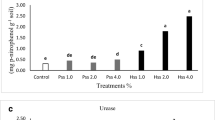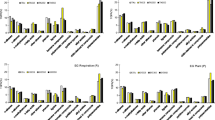Abstract
The effects of additions of three wastes from sugar mills on the properties of two acid soils were investigated. The wastes used were boiler ash and filter cake from a conventional mill and fly ash from a new mill, where filter cake is burnt. Additions of each of the wastes raised soil pH, reduced concentrations of exchangeable Al and total and monomeric Al in soil solution and increased maize yields in a pot experiment. Microbial biomass C and the percentage of organic C present as microbial biomass were decreased by additions of wastes but the effect was less marked at the higher rate of addition. Although basal respiration was decreased or unaffected by the lower rate of addition of wastes it was increased by the higher rate. The metabolic quotient increased in the order: control<filter cake<fly ash<boiler ash and values were greater at the higher rate of addition. It was suggested that the pH increase induced by wastes resulted in a smaller, more bacterially dominated, community with a higher respiratory rate. The activities of arylsulphatase, acid and alkaline phosphatase were all increased by waste additions. Concentrations of exchangeable NH4 + and NO3 - accumulated during incubation and arginine ammonification rate were all less at the higher rate of addition of each of the wastes. This was attributed to microbial immobilization of mineral N and arginine due to the wide C/N ratio of light fraction organic matter present in the study soil. It was concluded that all three waste materials were effective liming materials but their effect on soil microbial activity was complex.




Similar content being viewed by others
References
Acosta-Martinez V, Tabatabai MA (2000) Enzyme activities in a limed agricultural soil. Biol Fertil Soils 31:85–91
Adams T, Adams SN (1983) The effects of liming on soil pH and carbon contained in the soil biomass. J Agric Sci 101:553–558
Alef K, Kleiner D (1987) Applicability of arginine ammonification as an indicator of microbial activity in different soils. Biol Fertil Soils 5:148–151
Anderson JPE (1982) Soil respiration. In: Page AL (ed) Methods of soil analysis, part 2. Chemical and microbiological properties. SSSA, Madison, Wis., pp 837–871
Anderson TH, Domsch KH (1990) Application of eco-physiological quotients (qCO2 and qD) on microbial biomass from soils of different cropping histories. Soil Biol Biochem 22:251–255
Badalucco L, Grego S, Dell'Orco S, Nannipieri P (1992) Effect of liming on some chemical, biochemical, and microbiological properties of acid soils under spruce (Picea abies L.). Biol Fertil Soils 14:76–83
Berek AK, Radjagukguk B, Maas A (1995) The effect of different organic materials on the alleviation of Al toxicity in soybean on a red-yellow podzolic soil. In: Date RA, Grundon NJ, Rayment GE, Probert ME (eds) Plant-soil interactions at low ph: principles and management. Kluwer, Dordrecht, pp 570–584
Blakemore LC, Searle PL, Daly BK (1972) Methods for chemical analysis of soils. New Zealand Soil Bureau report 10A. Government Printer, Wellington
Bruce RC, Warrell LA, Edwards DG, Bell LC (1988) Effects of aluminium and calcium in the soil solution of acid soils on root elongation of Glycine max cv. Forrest. Aust J Agric Res 38: 319–338
Diattlof E, Harper SM, Asher CJ, Smith FW (1998) Effects of humic and fulvic acids on the rhizotoxicity of lanthanum and aluminium to corn. Aust J Soil Res 36: 913–919
Elkhatib EA, Hern JL, Staley TE (1987) A rapid centrifugation method for obtaining soil solution. Soil Sci Soc Am J 51: 578–583
Franzluebbers AJ, Zuberer DA, Hons FM (1995) Comparison of microbiological methods for evaluating quality and fertility of soil. Biol Fertil Soils 19:135–140
Harper SM, Edwards DG, Kerven GI, Asher CJ (1995) Effects of organic acid fractions extracted from Eucalyptus camaldulensis leaves on root elongation of maize (Zea mays) in the presence and absence of aluminium. In: Date RA, Grundon NJ, Rayment GE, Probert ME (eds) Plant-soil interactions at low ph: principles and management. Kluwer, Dordrecht, pp 585–588
Haynes RJ, Hamilton CS (1999) Effects of sugarcane production on soil quality: a synthesis of world literature. Proc S Afr Sugar Technol Assoc 73:45–51
Haynes RJ, Mokolobate MS (2001) Amelioration of Al toxicity and P deficiency in acid soils by additions of organic residues: a critical review of the phenomenon and the mechanisms involved. Nutr Cycl Agroecosyst 59: 47–63
Haynes RJ, Swift RS (1988) Effects of lime and phosphate additions on changes in enzyme activities, microbial biomass and levels of extractable nitrogen, sulphur and phosphorus in an acid soil. Biol Fertil Soils 6: 153–158
Hetherington SJC, Asher CJ, Blamey FPC (1988) Comparative tolerance of sugarcane, navybean, soybean and maize to aluminium toxicity. Aust J Agric Res 39:171–176
Kazunori S, Oba Y (1994) Effect of fungal to bacterial biomass ratio on the relationship between CO2 evolution and total soil microbial biomass. Biol Fertil Soils 17:39–44
Keeney DR, Nelson DW (1982) Nitrogen-inorganic forms. In: Page Al (ed) Methods of soil analysis, Part 2. Chemical and microbiological properties. SSSA, Madison, Wis., pp 643–698
Kerven GL, Edwards DG, Asher CJ, Hallman PS, Kokot S (1989) Aluminium determination in soil solution. II. Short-term colorimetric procedures for the measurement of inorganic monomeric aluminium in the presence of organic acid ligands. Aust J Soil Res 27: 91–102
Lerner BR, Utzinger JD (1986) Wood ash as a soil liming material. HortSci 21:76–78
Lin Q, Brookes PC (1999) Arginine ammonification as a method to estimate soil microbial biomass and microbial community structure. Soil Biol Biochem 31:1985–1997
Menzies NW, Kerven GL, Bell LC, Edwards DG (1992) Determination of total soluble aluminium in soil solution using pyrocatechol violet, lanthanum and iron to discriminate against micro-particulates and organic ligands. Commun Soil Sci Plant Anal 23:2525–2545
Mokolobate MS, Haynes RJ (2002) Comparative liming effect of four organic residues applied to an acid soil. Biol Fertil Soils 35:79–85
Neale SP, Shah Z, Adams WA (1997) Changes in microbial biomass and nitrogen turnover in acidic organic soils following liming. Soil Biol Biochem 29:1463–1474
Parfitt RL, Percival HJ, van der Lee G (1995) Aluminium species and pH in soil solution under different crops. In: Date RA, Grundon NJ, Rayment GE, Probert ME (eds) Plant-soil interactions at low ph: principles and management. Kluwer, Dordrecht, pp 817–822
Skjemstad JO, Clarke P, Taylor JA, Oades JM, McClure SG (1996) The chemistry and nature of protected carbon in soil. Aust J Soil Res 34:251–271
Slattery WJ, Morrison GR (1995) Relationship between soil solution aluminium and low molecular weight organic acids in a conservation cropping system In : Date RA, Grundon NJ, Rayment GE, Probert ME (eds) Plant-soil interactions at low ph: principles and management. Kluwer, Dordrecht, pp 589–593
Soil Classification Working Group (1991) Soil classification; a taxonomic system for South Africa. Soil and Irrigation Research Institute, Department of Agricultural Development, Pretoria
Tabatabai MA (1994) Soil enzymes. In: Weaver RW, Angle JS, Bottomley PS (eds) Methods of soil analysis, part 2. Microbiological and biochemical properties. SSSA, Madison, Wis., pp 775–833
Thomas GW (1982) Exchangeable cations. In: Page AL (ed) Methods of soil analysis, part 2. Chemical and microbiological properties. ASA, Madison, Wis., pp 159–165
Vance ED (1996) Land application of wood-fired and combination boiler ashes: an overview. J Environ Qual 25: 937–944
Vance ED, Brookes PC, Jenkinson DS (1987) An extraction method for measuring microbial biomass C. Soil Biol Biochem 19:703–707
Wardle DA, Ghani A (1995) A critique of the microbial metabolic quotient (qCO2) as a bioindicator of disturbance and ecosystem development. Soil Biol Biochem 27:1601–1610
Acknowledgements
We are grateful to Mr J H Meyer of the South African Sugar Experimental Station for collection and analysis of soil and mill wastes.
Author information
Authors and Affiliations
Corresponding author
Rights and permissions
About this article
Cite this article
Dee, B.M., Haynes, R.J. & Graham, M.H. Changes in soil acidity and the size and activity of the microbial biomass in response to the addition of sugar mill wastes. Biol Fertil Soils 37, 47–54 (2003). https://doi.org/10.1007/s00374-002-0562-5
Received:
Accepted:
Published:
Issue Date:
DOI: https://doi.org/10.1007/s00374-002-0562-5




